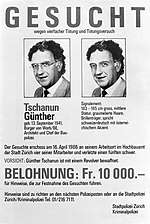Zurich massacre
1349 in Europe14th-century massacres14th century in SwitzerlandAntisemitism in SwitzerlandHistory of Zürich ... and 2 more
Jewish Swiss historyMedieval anti-Jewish pogroms

The Zurich massacre was an anti-Semitic episode in Zurich, Switzerland, which occurred in 1349. The incident was caused by antisemitism in the city due to the alleged murder of the son of a Zurich man, and fueled by the subsequent accusations of well poisoning. This event took place in the frame of the widespread Black Death persecutions, where the Jews were accused of spreading the bubonic plague (known as Black Death).
Excerpt from the Wikipedia article Zurich massacre (License: CC BY-SA 3.0, Authors, Images).Zurich massacre
Uraniastrasse, Zurich Altstadt
Geographical coordinates (GPS) Address Nearby Places Show on map
Geographical coordinates (GPS)
| Latitude | Longitude |
|---|---|
| N 47.374444444444 ° | E 8.5411111111111 ° |
Address
Uraniastrasse
Uraniastrasse
8001 Zurich, Altstadt
Zurich, Switzerland
Open on Google Maps








